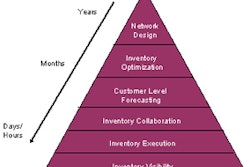Oftentimes the motivations for a merger and/or acquisition are the savings and cost synergies that can be generated from the increased scale and overlapping operations of the combined companies. These synergies generally come from two areas: internal headcount and external vendor spend. Due to the supply chain management (SCM) organization's focus on optimizing vendor relationships and internal spend patterns to reduce costs and increase productivity, SCM is well-positioned to lead the external vendor spend effort with a structured synergy capture program to maximize savings.
Embarking on a merger or acquisition without a strategy or, better yet, a formal program to realize the potential synergies as effectively and efficiently as possible can ultimately lead to failure. Because the synergies are crucial to the future viability of the combined company, the respective SCM organizations should have a leading role in identifying the synergy savings required for the merger or acquisition to succeed.
To maximize merger or acquisition synergies, SCM should drive a structured, regimented program focused on aligning external vendor spend in two ways:
- Strategic Cost Avoidance — cancelling or avoiding large capital projects by leveraging the combined company's assets, and
- External Vendor Spend Optimization — using the enhanced bargaining power of the merged company's combined spend and rationalizing common spend categories.
Lesson Learned — The organizational ambiguity, politics and human resource issues associated with a merger or acquisition are major sources of distraction. Strong leadership is required to maintain a laser focus on achieving synergy goals.
Doug Holly, vice president of technology projects for JDSU, an enabler of broadband and optical innovation for communications, commercial and consumer markets, who has been involved in three acquisitions (including being part of an acquired company), stresses the importance of senior leadership.
"There is never too much communication in a merger or acquisition. It is essential that the synergy savings teams are brought together with the leadership team to discuss cost savings efforts and prioritize activities," said Holly.
Lesson Learned — Synergy realization can be accelerated and maximized if the up-front analysis can be performed early — even prior to the close of the transaction. Within regulatory constraints, the optimal scenario is to have sourcing teams ready to launch a portfolio of synergy capture projects on "Day 0."
Bryan Carter, vice president of facilities and procurement for Neustar, a leading provider of essential clearinghouse services to the global communications and Internet industry, advocates for SCM to fulfill an integral role on the team making the merger and acquisition decision in the first place. Carter, who has helped Neustar execute four acquisitions in the past three years, advises that the decision to make the merger or acquisition (or at least the strike price for the transaction) may be significantly impacted by the due diligence regarding synergy realization. In fact, the purchase price may be conditional, with a portion of the price held in reserve, until the SCM due diligence on each company's facilities, assets, systems and vendor relationships can be further determined.
"Each merger or acquisition needs to be evaluated by four or five different stakeholders in order to make the best decisions and best prioritize savings opportunities," says Carter.
Synergy Capture Options Help Evaluate the Opportunities
Once the merger or acquisition decision has been finalized, the strategy or process used to drive synergy savings on external vendor spend is largely determined by the characteristics of the categories of goods and services the legacy companies are buying, and the vendors from which they are buying them.
There are three primary synergy capture options: Volume Shift, Renegotiate and Competitive Bid. To determine which of these is the best option, the team must identify overlaps in spend categories (i.e., the types of goods and services purchased); and in vendors, evaluate whether the goods and services are the same, substitutable or different, and determine if the vendors are the same or different. For example, different goods/services from the same vendor may prompt a renegotiated contract, while the same goods/services from the same vendor may be appropriate for a volume shift or a renegotiation. See Image 1.
These categories can be used to identify synergy capture options to be considered for any spend category, contract or vendor. Each may be applied to i) an entire spend category or contract, in which case the contract from which volume is being removed would be terminated, or ii) part of the spend category or contract, perhaps to avoid invoking a minimum commitment shortfall penalty. These options are not mutually exclusive over time. For example, a short-term strategy may include immediate volume shifts within a spend category or between contracts to realize "quick hit" synergies; this can be followed by a long-term strategy that includes a category-wide, competitive bidding sourcing event or contract renegotiation to realize greater, long-term synergies. See Image 2.
Four-step Synergy Capture Process Leads to Success
To capture the defined synergies, there are four key steps that should be followed.
- Step 1 — Determine Synergy Initiatives
- Step 2 — Prioritize Initiatives Based on Business Impact
- Step 3 — Develop Resource and Synergy Capture Plan
- Step 4 — Execute the Synergy Capture Program
Step 1: Determine Synergy Initiatives
In this step, each legacy company needs to share category spend, vendor spend data and vendor contract terms to identify areas to be assessed. This analysis should be conducted as far in advance of the execution of the merger or acquisition transaction as possible in order to accelerate synergy capture following deal completion.
"At Neustar, we learned something new in each acquisition. Today we have a process guide to make sure every scenario is taken into consideration. Many companies focus on growing revenue as a result of the merger or acquisition, but it is essential to have a team in place ready to look at the synergies and efficiencies that can be generated by streamlining repetitive functions and combining teams quickly," said Carter.
Prior to legal execution of the transaction, the amount of information sharing between the legacy companies, and the conditions under which it can be jointly analyzed, is typically determined by the Legal department as some types of information sharing may violate Department of Justice anti-competition rules. In some cases, information needed to enable the analysis may be declared "non-competitive" and shared relatively openly. Competitively sensitive information may need to be analyzed in a "clean room" environment that has physical, logical and procedural safeguards to ensure that this information is not shared or made known outside of its confines. Ideally, collaboration with the Legal department on an individual, data-element-by-date-element basis should take place to determine the specific information that may be shared and the timing thereof.
Lesson Learned — Challenge the Legal department to closely examine criteria for defining information to be shared between legacy companies as "competitively sensitive." The more information that can be shared outside of the clean room and ahead of the merger or acquisition transaction closing, the faster and more efficient the analysis to develop the Synergy Capture Workplan will be.
Assuming the companies are able to share information, areas for synergy capture may be identified relatively quickly under the following scenarios:
- Common Vendors — if both legacy companies are buying goods and services from the same vendor, then the vendor may be approached on several fronts:
- Common Categories — if both companies are buying the same (or substitutable) category of goods or services, they likely may be buying them from completely or partially different suppliers. In this case, the merger or acquisition may introduce increased supplier fragmentation within a category. This fragmentation can yield synergy savings if sourcing and/or contracting events can be used to rationalize the fragmented supplier base down to a more optimal portfolio of suppliers for the category. One of the most effective ways to reduce this fragmentation is to launch a competitive category-wide sourcing event for the category (i.e., Option #3 — Competitively Bid).
- Business Unit Requests — independent of the category spend analysis and vendor spend data, the Business Units may be able to directly identify high synergy-opportunity initiatives for SCM to add to its list of initiatives under consideration.
— If one legacy company has more favorable pricing than the other, then the merged company should immediately be able to purchase its entire merged volume under the more favorable pricing (i.e., Option #1 — Volume Shift)
— Better yet, the increased volume of the merged company may be used as leverage to renegotiate more favorable pricing and terms than either legacy company could achieve on its own (i.e., Option #2 — Renegotiate)
Lesson Learned — Re-examine in-house vs. outsource decisions. If the legacy companies have made different choices, they bring information to the table that will be instructive in making those decisions for the merged entity.
Although SCM may be well positioned to do the detailed contract analysis and financial modeling necessary to identify the range of potential synergy initiatives, only the business units can bring to bear the balanced, real-world trade-offs and technical and operational constraints on top of what may be contractually feasible and financially viable. It is imperative that SCM foster the cross-functional collaboration needed to accomplish this.
Lesson Learned — Leverage existing contract and category managers to speed the analysis process. There is no replacement for their institutional knowledge. Use uniform assessment templates to drive consistent analysis across a distributed workforce.
SCM should partner with the functional business units to incorporate operational, technical and market-facing considerations and constraints into the synergy capture option assessment and subsequent prioritization. The contract and category assessment templates should reflect this need and ensure that business unit stakeholders' views are represented.
See Image 3 — Determining Synergy Capture Options .A common failure point within this process is insufficient prioritization and resource allocation due to the legacy companies' disparate category structures and naming conventions for classifying spend. Even with standard spend categories, such as Universal Standard Products and Services Classification (UNSPSC) codes, different companies may still implement spend coding differently and classify the same spend under different category codes. Although complex and time-consuming, it is imperative to map each company's spend codes to each other so spend may be compared on an apples-to-apples basis.
This cross-company spend analysis will help identify spend categories that are over-fragmented and can be sourced to produce synergy savings. Also, for both the category spend analysis and vendor spend, many companies have data integrity challenges. For example, the spend may have been incorrectly categorized or there may be multiple instances of the same vendor in the financial systems with spend spread across all instances. These discrepancies carry over into the synergy analysis if not corrected.
Lesson Learned — Data capture and normalization can be challenging given the different definitions, processes and tools used by the pre-merger companies. Rules for capturing data and reasonable assumptions (where necessary) for normalizing spend categories must be agreed upon prior to analysis. As it is rare to have the time and resources required to completely resolve all of the data integrity or category mapping issues, apply the 80/20 rule to correct and map the majority of spend in a reasonable amount of time.
Step 2: Prioritize Initiatives Based on Business Impact
Given the scarce resources that all enterprises face, organizations must prioritize the identified synergy capture initiatives in order to maximize return on investment (ROI):
- Higher synergy yield projects with shorter pay-back periods and/or those that are relatively easier to achieve should be prioritized first — the so-called "low hanging frut"
- Longer-term projects that are more difficult to achieve may be de-prioritized; however, this should be balanced with potential high-synergy yields that may be worth the investment of time and resources
Holly advocates for senior leadership to be involved in the prioritizing of synergy initiatives and encourages each company to closely evaluate the other's processes. "Each company brings to the table a unique way of tackling problems and oftentimes each company can learn a better way to do something from the other." See Image 4.
Using a synergy prioritization scheme to consistently balance the various ROI components with business priorities is a useful approach. An ROI-based prioritization may be approximated by using a set of defined criteria that encompass the major elements of an ROI calculation. For example:
- Estimated Savings — the most direct measure of synergy value and generally given the most weight of all criteria
- Spend — often used as a proxy for savings if savings cannot be predicted with an acceptable confidence interval
- Speed of Savings Capture — the payback period or time required for synergies to be realized as a result of the project
- Resources Required — the full time equivalents (FTE) personnel or other investments required to execute the synergy initiative
- Business Impact — importance placed by the business on meeting the completion date for the project.
- Stakeholder Buy-in — degree to which business stakeholders will advocate for, support and provide sufficient resources to execute the project successfully
This approach will yield a prioritized list of synergy capture initiatives ordinally ranked relative to estimated ROI (See Image 5.
Step 3: Develop Resource and Synergy Capture Plan
In addition to identifying synergy savings, it is important to project an estimation of when those savings will be realized and booked. The more qualified resources that can be brought to bear, the higher the number of projects that can be worked in parallel and the more synergy realization may be accelerated.
Resource planning and scheduling requires assessing current resources, assigning those resources to the prioritized projects based on qualifications and skill sets, determining the appropriate team mix for each project, estimating the time it will take for the resources to complete the projects and then re-assigning resources as they become available. This will produce waves of completed synergy projects and corresponding synergy realization over time.
A synergy capture steering committee and sub-teams for each of the operational functions of the business, e.g., IT, finance, HR, operations, with weekly meetings is an effective way to assure open and clear lines of communication, suggests Holly. "It is important that real issues can be escalated and resolved quickly."
In order to accurately capture and reflect the benefits of all this investment and activity, a savings tracking system is needed to identify the expected and actual synergies that will be captured over time and to provide leadership with performance reports, including forecasts, accomplishments and variance analysis. It is important that the definition and methodology used to calculate synergy savings be thoroughly understood by everyone reporting those savings. If there is variation between individuals on this calculation, then the numbers across projects cannot be added together and savings reporting will be inaccurate.
Lesson Learned — Inconsistencies in savings definition can lead to an ineffective savings tracking mechanism. Detailed synergy savings definitions need to be discussed, approved and applied consistently. It is often helpful to establish a centralized savings or financial modeling "center of excellence" that can be called upon by staff for assistance in developing savings models and documenting savings. The savings tracking system should be user friendly to encourage staff to document their savings comprehensively and in a timely manner. Synergy efforts may be wasted if the savings are never officially documented and booked.
Step 4: Execute the Synergy Capture Program
Running the synergy capture workplan as a distinct and comprehensive program with an established governance structure to monitor progress and make changes as necessary will help ensure success. With all of the activities, competing priorities, cultural conflicts and confusion that accompany many mergers and acquisitions, it is easy to lose management focus and momentum in execution.
Part of a successful synergy capture plan is having dedicated resources — people who are not trying deliver synergies along with their other operational responsibilities. "It is important to clear the plates of a few individuals to drive the process. They are able to get the job done quicker and have greater insight as they are immersed in the process and not dealing with it part-time," adds Holly.
Lesson Learned — The governance structure should include Project Management Office (PMO) functions (e.g., regular progress reporting, issue identification/escalation/resolution procedures) and incorporate executive and management sponsorship and participation to ensure that workplan execution stays on track.
Some form of the governance structure should remain in place for as long as the synergy savings will be tracked and reported, which may be long after the merger or acquisition has closed. Visibility and accountability are vital in maintaining focus in this area over the long term. Holly made effective use of this critical element for the JDSU acquisition of Acterna, where he reported results directly to the CEO. This level of visibility helped ensure that everyone responsible maintained motivation to report synergy savings in an accurate and timely manner.
Oftentimes, it is beneficial to leverage the approaches, methodologies, processes, tools and templates currently in place for executing SCM projects. Key options include:
- Adopt the practices of one of the legacy companies. This allows for a completely uniform approach across all project teams, but forces the staff of one legacy company to learn a new approach.
- Allow both legacy company approaches to be used. Here, staff from both legacy companies are allowed to use the approach with which they are most familiar, but this does not ensure uniformity across all project teams. Also, portions of teams with a mix of staff from both legacy companies will still need to adopt a new approach.
- Develop a single, hybrid approach, leveraging best practices from both legacy companies. Creating a new, common approach across all project teams fully leverages best practices, but requires all staff to learn a modified version of their approach (it also requires investment to do the analysis necessary to develop the hybrid approach).
"It's important in the decision making process to have consensus. If it looks like one side 'won' and one side 'lost' there will be detrimental impacts on morale and the cultural integration that needs to occur," says Holly.
Big Savings Come From a Dedicated Program
Mergers and acquisitions are opportunities for SCM organizations to drive savings by demonstrating the value that a structured synergy capture and sourcing process can bring to the enterprise.
"A merger or acquisition is an opportunity for the supply chain management organization to prove the value that synergy savings efforts deliver and to get executive-level attention and respect," says Carter.
While a successful synergy savings effort represents an extensive commitment of resources, SCM can deliver significant value to the business by producing high leverage resources. An average $150,000 per year in employee resource commitments from SCM can produce multi-million dollar synergies.
But successful execution also requires a strong partnership between SCM and the business, particularly if achieving significant synergy savings requires some sacrifice on the part of the business. SCM must be seen as a trusted business partner, not merely an after-the-fact contracting function. It is important to understand that if SCM takes ownership of the external vendor spend synergy capture program, SCM will also be held accountable for actually realizing aggressive synergy forecasts, so it is imperative to have a well-constructed plan in place to ensure SCM follows through and meets its commitments.
About the Authors: Andy Sealock and Marc Tanowitz are both principals at strategic sourcing, supply chain and outsourcing advisory firm Pace Harmon. On the Web at www.paceharmon.com.


















